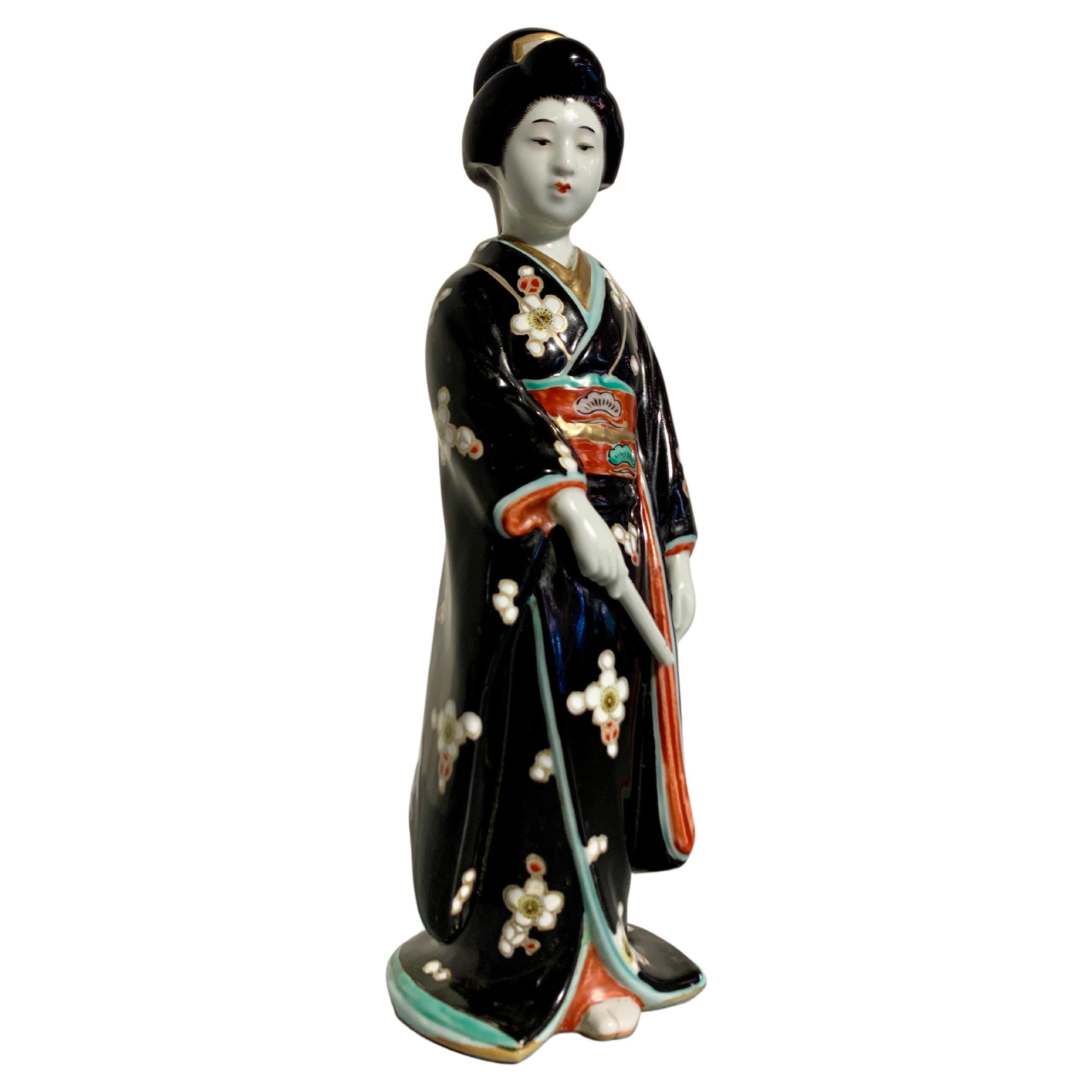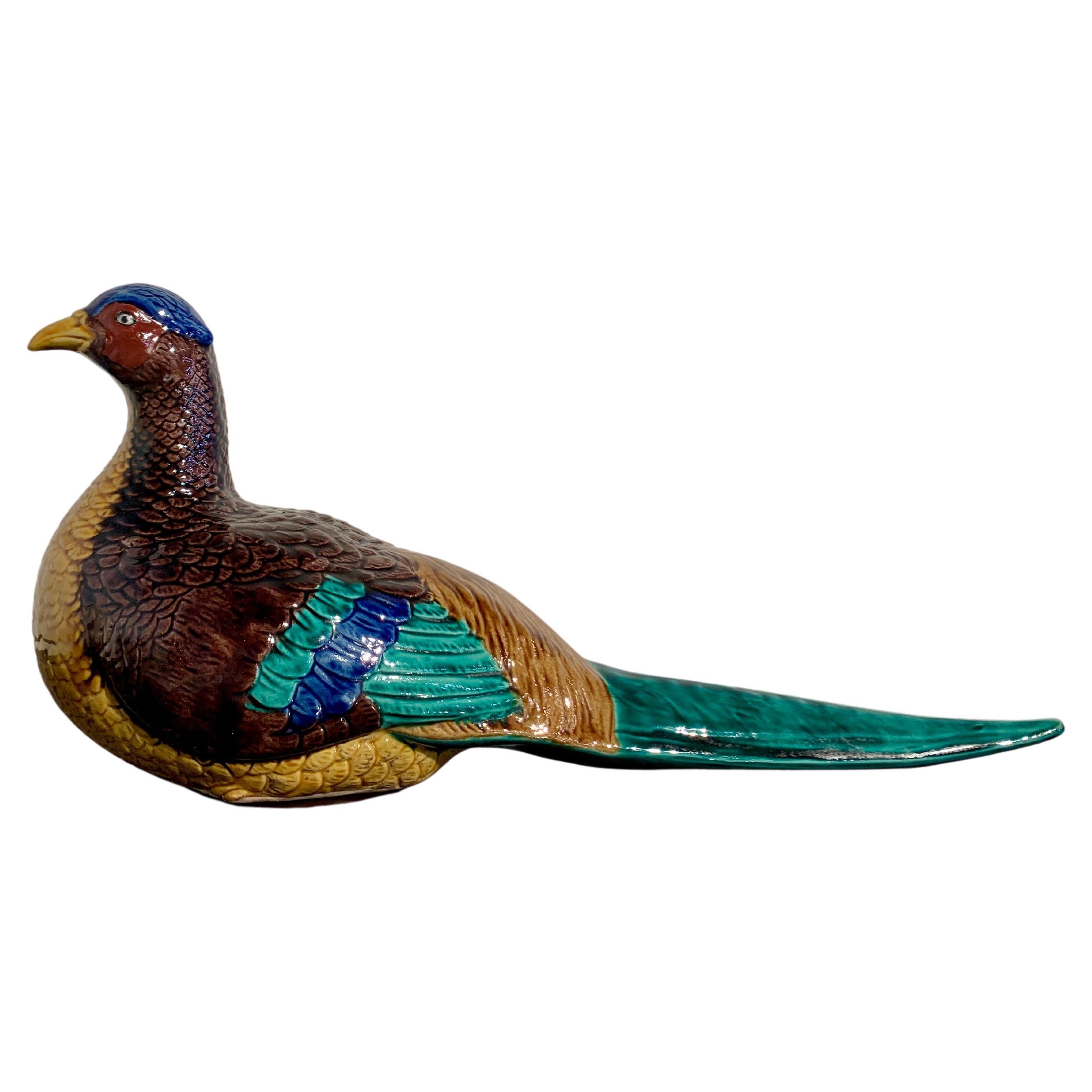Items Similar to Miyanaga Tozan III Seihakuji Glazed Tokkuri, Showa Era, Japan
Want more images or videos?
Request additional images or videos from the seller
1 of 17
Miyanaga Tozan III Seihakuji Glazed Tokkuri, Showa Era, Japan
About the Item
A sublime and elegant seihakuji (qingbai or celadon) glazed porcelain tokkuri (sake bottle) by Miyanaga Tozan III, also known as Miyanaga Rikichi, (b. 1935), Showa Period, circa 1980's, Japan.
The sake bottle, called a tokkuri, is delicately potted of fine porcelain and glazed all over in a subtle pale blue green celadon glaze known as seihakuji (called qingbai in China). The thin, nearly transparent glaze is luminous, evoking water or moonlight.
Contrasting beautifully with the subtleness of the glaze is the bold and unexpected spiraling design that seems to torque the bottle, underscoring the potter's masterful understanding of clay, geometry, and form. Five raised lines descend straight down the neck from the mouth of the bottle before turning elegantly and dramatically at the shoulder, straightening again down the sides, and turning once again just above the foot. The raised ridges of the lines barely hold the thin seihakuji glaze, revealing the pure white porcelain below.
The tokkuri of somewhat typical shape, with an ovoid body, squared shoulders, tall, narrow neck, and elegantly everted mouth, all set on a short recessed foot.
Holding the bottle is a joy. The ridges are unexpectedly smooth. The glaze has a soft and supple feel. And the bottle seems to conform to one's hands. Looking down into the mouth, the twisted lines almost feel like swirling water, creating a whirlpool effect. A similar and even stronger effect is achieved while viewing the foot.
The bottle with an inscribed signature to the underside reading "Ri" (for Rikichi) with a collection number in ink. The tokkuri comes with the original signed tomobako. The exterior of the lid inscribed "Seihakuji" and "Tokkuri". The interior of the lid signed "Miyanaga Rikichi saku" and sealed.
Kyoto based potter Miyanaga Tozan III (b. 1935) was previously known as Miyanaga Rikichi before taking over his father's mantle in 1999. Part of the second generation of avant-garde ceramicists, he is the third in a line of celebrated and accomplished ceramicists, beginning with his grandfather, Tozan I (1868 - 1941). His daughter, Miyanaga Aiko, is set to eventually take over the family kiln.
Provenance: Christie's Japanese and Korean Art, March 24, 2003, lot 201.
For a vase from the same series, please see lot 1123 from the Sotheby's September 2023 sale, Freddie Mercury: A World of His Own / In Love with Japan
- Dimensions:Height: 7.5 in (19.05 cm)Width: 4.75 in (12.07 cm)Depth: 4.75 in (12.07 cm)
- Style:Showa (Of the Period)
- Materials and Techniques:
- Place of Origin:
- Period:1980-1989
- Date of Manufacture:circa 1980's
- Condition:Wear consistent with age and use. In fine condition, with no chips, cracks, or repairs. The wooden tomobako missing one bar to the interior of the cover.
- Seller Location:Austin, TX
- Reference Number:1stDibs: LU894736936232
About the Seller
5.0
Gold Seller
These expertly vetted sellers are highly rated and consistently exceed customer expectations.
Established in 2001
1stDibs seller since 2010
305 sales on 1stDibs
Typical response time: 1 hour
- ShippingRetrieving quote...Ships From: Austin, TX
- Return PolicyA return for this item may be initiated within 7 days of delivery.
More From This SellerView All
- Ono Kotaro Seihakuji Glazed Vase, Heisei Era, circa 2000Located in Austin, TXA subtle and finely potted seihakuji glazed vase by Japanese contemporary ceramicist Ono Kotaro (b. 1953), circa 2000. Ono Kotaro is known for balancing...Category
Late 20th Century Japanese Ceramics
MaterialsPorcelain, Cedar
- Japanese Aote Kutani Phoenix Censer, Koro, Showa Era, JapanLocated in Austin, TXA fantastic Japanese Aote type Kutani incense burner, koro, in the form a phoenix, Showa era, circa 1930's, Japan. The censer, koro, gracefull...Category
Vintage 1930s Japanese Showa Ceramics
MaterialsPorcelain
- Japanese Kutani Porcelain Figure of a Geisha or Bijin, Showa Era, 1930's, JapanLocated in Austin, TXA lovely Kutani porcelain model of a beautiful woman, bijin, or perhaps a geisha, Showa era, circa 1930's, Japan. A charming and delightful Japanese Kutani enameled porcelain figure of a bijin or geisha, early Showa Era, circa 1930's, Japan. The elegant figure of a beautiful woman, called a bijin, or perhaps a geisha, is portrayed dressed in full kimono and holding a closed folding fan in one hand. Her kimono of a rich and deep blue hue, with images of plump pomegranates in gilt. Her wide obi of a striking red color, and patterned with branches of pink blossoms. One foot, clad in a white tabi...Category
Vintage 1930s Japanese Showa Sculptures and Carvings
MaterialsPorcelain
- Japanese Imari Nanban Nesting Bowls, Set of 3, Showa Era, circa 1930s, JapanLocated in Austin, TXA wonderful set of three Japanese Imari Porcelain "Black Ship" Nanban nesting bowls, Showa Era or earlier, 1930s or earlier, Japan. The bowls wonderfully decorated in the Imari c...Category
Vintage 1930s Japanese Showa Ceramics
MaterialsPorcelain
- Japanese Kutani Porcelain Figure of a Bijin or Geisha, Showa Era, 1930's, JapanLocated in Austin, TXA charming and delightful Japanese Kutani enameled porcelain figure of a bijin or geisha, early Showa Era, circa 1930's, Japan. The elegant figure of a beautiful woman, called a bijin, portrayed dressed in full kimono and holding a fan in one hand. Her kimono of deep black with scattered cherry blossoms in white and outlined in gilding. Her wide obi of coral color, and patterned with stylized clouds of turquoise green and puce. One foot, clad in a white tabi...Category
Vintage 1930s Japanese Showa Sculptures and Carvings
MaterialsPorcelain
- Japanese Kutani Pheasant Sculpture, Okimono, Showa Era, Early 20th CenturyLocated in Austin, TXA spectacularly glazed Japanese Kutani model, okimono, of a pheasant, Showa era, early 20th century, Japan. The okimono, or decorative sculpture, in the form of a magnificent phea...Category
Vintage 1930s Japanese Showa Ceramics
MaterialsPorcelain
You May Also Like
- Japanese Ceramic Vase by Ito Tozan I Meiji PeriodBy Ito Tozan ILocated in Atlanta, GAThis stoneware vase of a jar form was finely decorated with low relief carving and delicate colored glazes depicting bundles of peony flowers. It was made by Ito Tozan I (1846-1920) circa 1890-1900s in the late Meiji Period. The color pallet was both bold and subtle, with dark green and rusty leaves with golden outlines and white and light yellow peony petals covering much of the surface. Impressed with potter's mark on the base. Examples of two pieces by Ito Tozan I were in the collection of MNAAG (Guimet) Paris. Inventory no. MG 13790 an 13792. A vase with similar shape and decoration techniques is featured as Lot 1340 Fine Japanese Art, 13 Sep 2017 Bonhams New York Tozan Ito I established his ceramic business in Kyoto 1867. His studio made both porcelain and stoneware in a style some considered Satsuma while they retained a sophistication of Kyoto ware...Category
Antique 1890s Japanese Japonisme Ceramics
MaterialsCeramic
- Collection of Four Japanese Tamba Tokkuri Sake BottlesLocated in Atlanta, GAA set of four Japanese Ceramic Tokkuri Sake storage bottles circa early 20th century (Meiji to Taisho period). The bottles were made in Tamba (Tanba) kil...Category
Early 20th Century Japanese Japonisme Ceramics
MaterialsCeramic
- Japanese Porcelain Hibachi of the Showa Period or Slightly Earlier.Located in Hudson, NYThis porcelain Japanese hibachi or “Fire Bowl” was made in Japan circa 1900 to 1925. This is a traditional Japanese heating device and consists of a fireproof cylinder or box that ca...Category
Early 20th Century Japanese Showa Ceramics
MaterialsPorcelain
- Landscape Showa Period Japanese 20th Century Porcelain Kutani EtsuzanLocated in Amsterdam, Noord HollandDescription Lovely and detailed piece with a great decoration of a poem and landscape Condition Overall Condition some enamel loss and 1 small chip to rim. Size 193x135x28mm D...Category
20th Century Japanese Showa Ceramics
MaterialsPorcelain
- Japanese Okinawa Ceramic Showa Period Awamori Sake Pottery Dachibin Hip FlaskLocated in Studio City, CAA wonderful hand painted and decorated traditional Okinawan ceramic awamori/sake flask, also known as a dachibin. These handcrafted pieces were originally designed to be carried and worn against the hip, hence the curved shape. This piece is from a collector of fine Japanese and Asian ceramics and pottery works - a collection like no other we have seen. We believe this flask is from the early to mid-1900s. Would be a great addition to any Japanese ceramics...Category
Early 20th Century Japanese Showa Ceramics
MaterialsCeramic
- Showa period Japanese 20th Century Porcelain Kutani Bird Plate in BoxLocated in Amsterdam, Noord HollandLovely and detailed piece with a great decoration of a bird in a garden scene. Condition Overall condition perfect (but crackled). Size 225 x 25mm D x H Period 20th century.Category
20th Century Japanese Showa Ceramics
MaterialsPorcelain
Recently Viewed
View AllMore Ways To Browse
14th 15th Century
Green Bamboo Metal
Antique Asian Blue Glazed Vase
Qing Elephant
Chinese Porcelain Brushpot
Fukagawa Arita Plate
Lacquer Snuff Bottle
Chinese Hand Painted
Qing Chinese
Chinese Offering Fruit
Black Asian Pottery
China Republic
Antique Chinese Celadon Crackle Vase Large
17th Century Chinese Export Saucer
18th Century Chinese Ceramic Saucer
Chinese Chenghua Porcelain
Early Kozan
Blanc De Chine Dog





